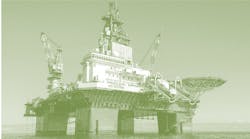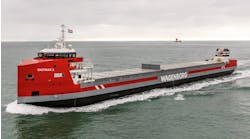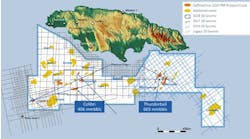View Article as Single page
Analysis of the realistic pipe pull-through was then performed to determine the system's sensitivity to property mismatches between pipe joints, arising from variation in the manufacturing process. The study considered the impact of a variation in material yield strength, pipe wall thickness and yield to tensile ratio between adjoining pipe sections, with a back tension of 500 kN applied to represent the tension normally applied to each pipe by the deck tensioner. It involved modeling a 24.4-m (80-ft) brick element pipe length to represent two typical joint lengths, but of differing material properties to model mismatch.
One conclusion was that the mismatches result in increased ovalization in the bare field joint region, an effect most pronounced for wall thickness and yield strength mismatches. Another was that the pipe is more sensitive to ovalization when its leading length (pulled around the aft wheel first) has greater material strength or section modulus, compared with the trailing section. The company will use the results to define a full installation envelope and detailed pipelay assessment specific to each project the vessel performs.
During installation of a rigid pipeline, the pipe will be unsupported within the free span between the vessel's aft and tower wheel and also when in the catenary during installation. To determine the acceptability of these known free spans, Ceona conducted analyses of environmental loading and vessel motions in relation to the pipe's fatigue life. These suggested that fatigue would be greatest when the vessel is exposed to prolonged periods of beam seas, with wave heights at or above the vessel's weather installation limit. In practice, the company will take into account metocean data, pipe material, and joint weld properties for each individual project.
Then followed simulated bend trials, in collaboration with Cladtek International, of a range of 8-in. nominal bore carbon steel pipes of varying composition to assess strain behavior and also how deformation of the pipe wall develops during the bending process. Findings were then compared with computer simulations and finite element analysis (FEA) models of the system.
Results suggested generally good correlation. Ceona commissioned an FE software specialist to develop a parametric tool to create individual cases for homogeneous pipe, each with a specified outer diameter, wall thickness and axial tension, and also to redefine the parameters and modeling conditions specific to each pipe configuration. The resultant products reduced the time taken to construct each model from hours to less than a minute. Further software followed, developed in-house and by consultants, to extract required data for ovality, stresses and strains in the model, allowing a time history to be compiled as the pipe is pulled through the vessel's lay spread.
Finally, Ceona commissioned an independent verification of the lay system, results of which were virtually identical to the company's own FE modeling. Ceona claims comparative FEA modeling of a conventional lay spread indicates pipe ovalization similar to results for theCeona Amazon. It will devise future test schedules to define a full installation envelope and detailed pipelay assessment specific to each project.
The company plans to pitch the vessel for relatively short-term construction jobs, particularly in the deepwater Atlantic triangle region. It has been designed to reach speeds of up to 14 knots, with the 28-MW MAN-supplied power plant providing 20% better fuel efficiency than some competing vessels, according to Mark Preece, executive vice president for commercial and business development.
This was Lloydwerft's first offshore construction job. The shipyard was looking to build an offshore track record and was able to offer a competitive price, Preece said. "We are happy with the quality of the vessel and its workability, and the quality of their supply chain has been outstanding."



